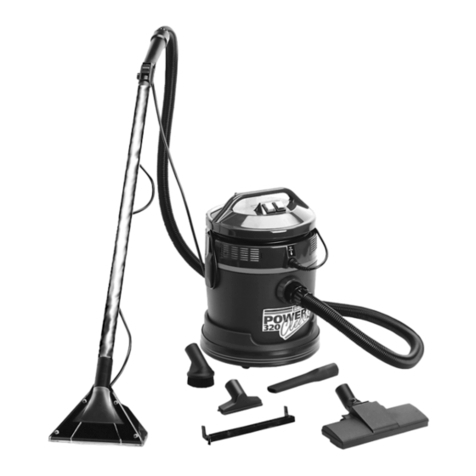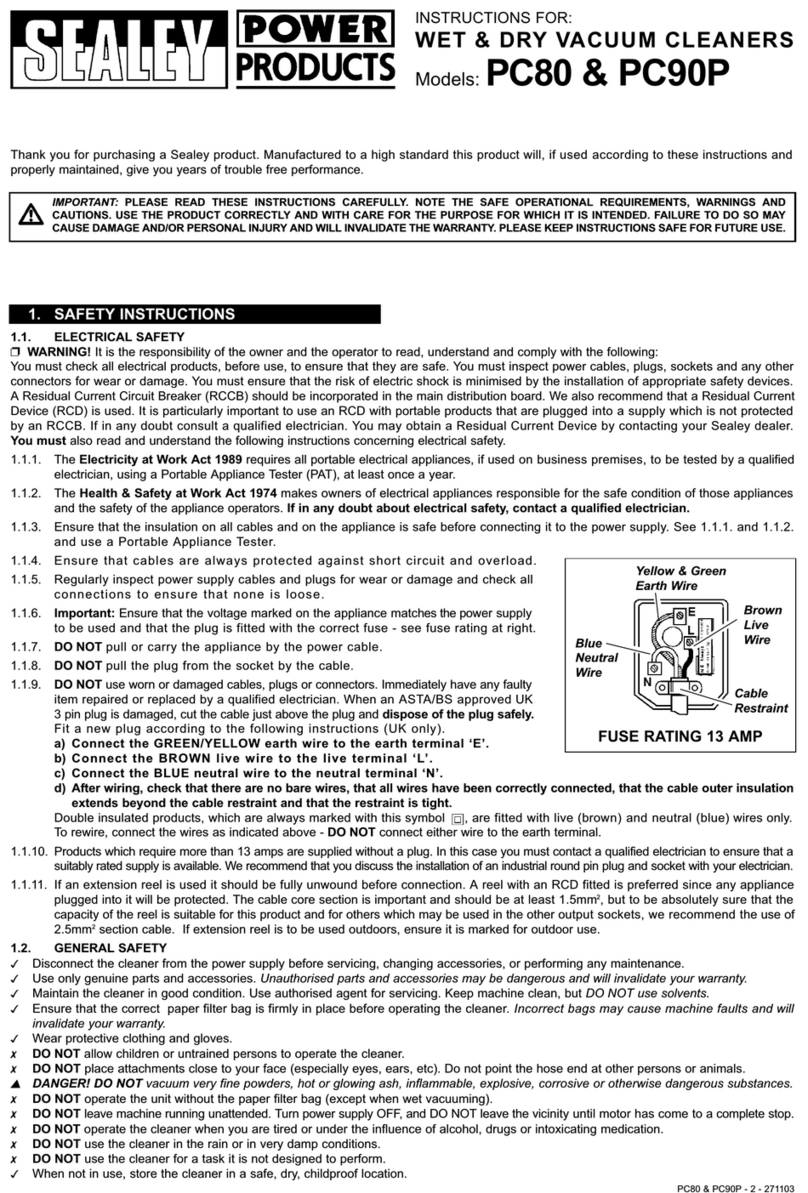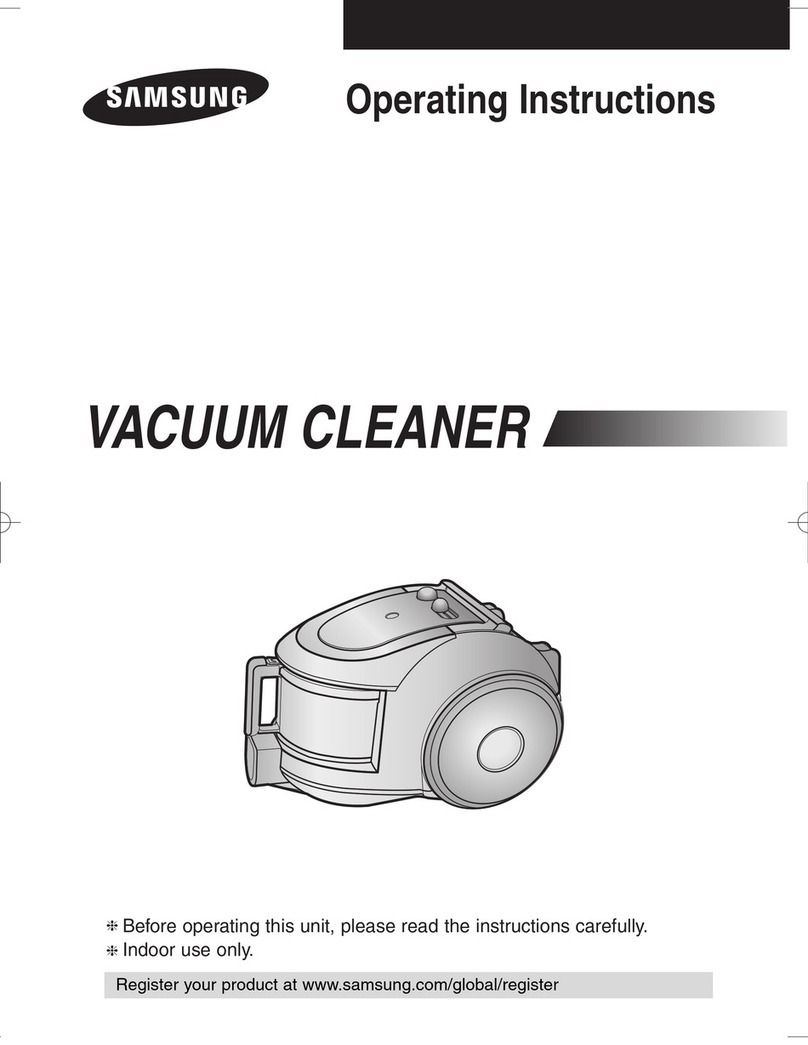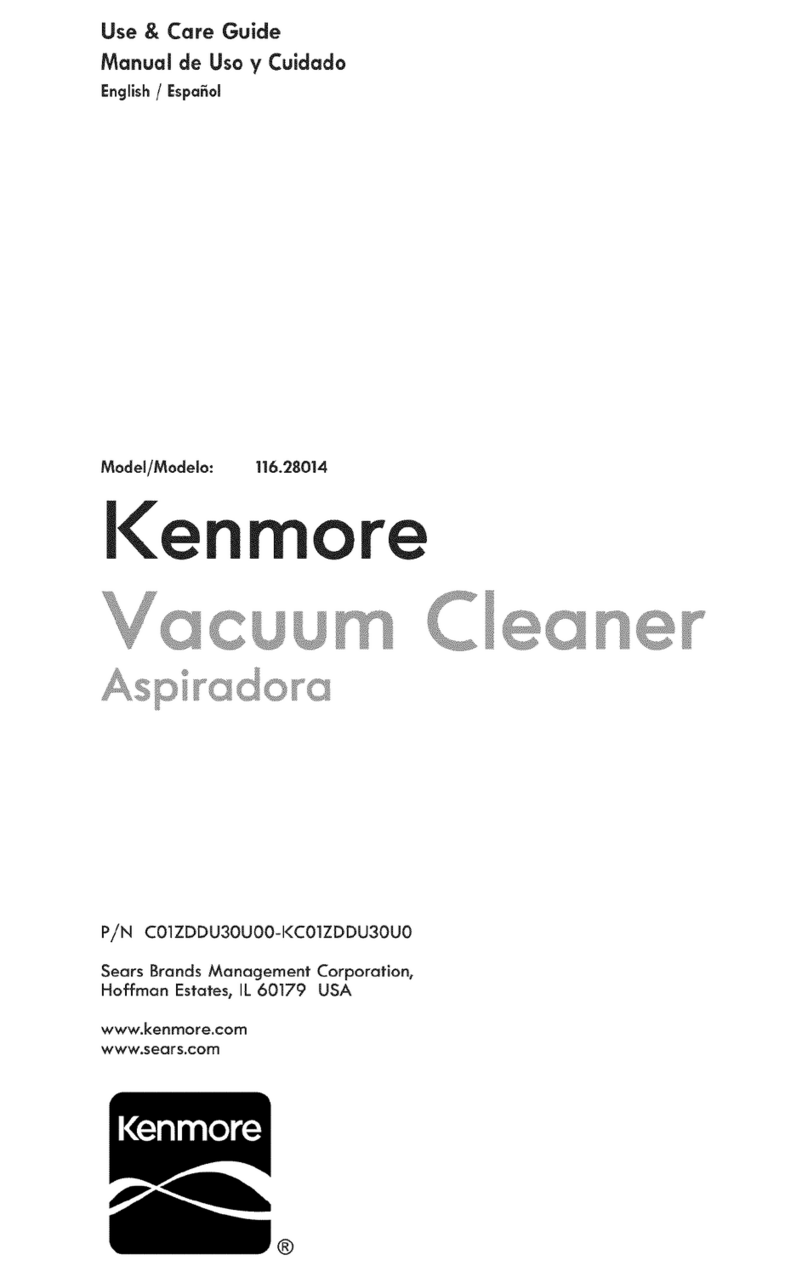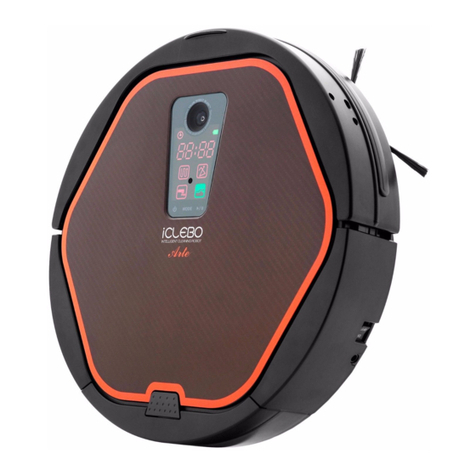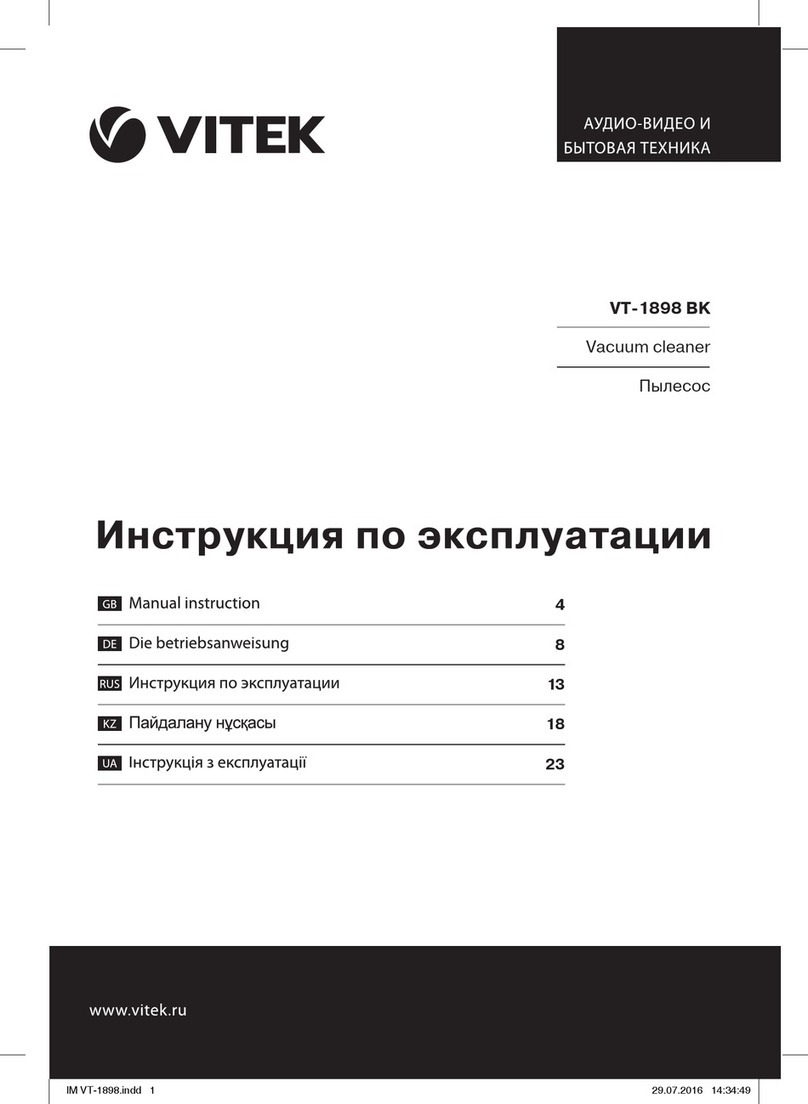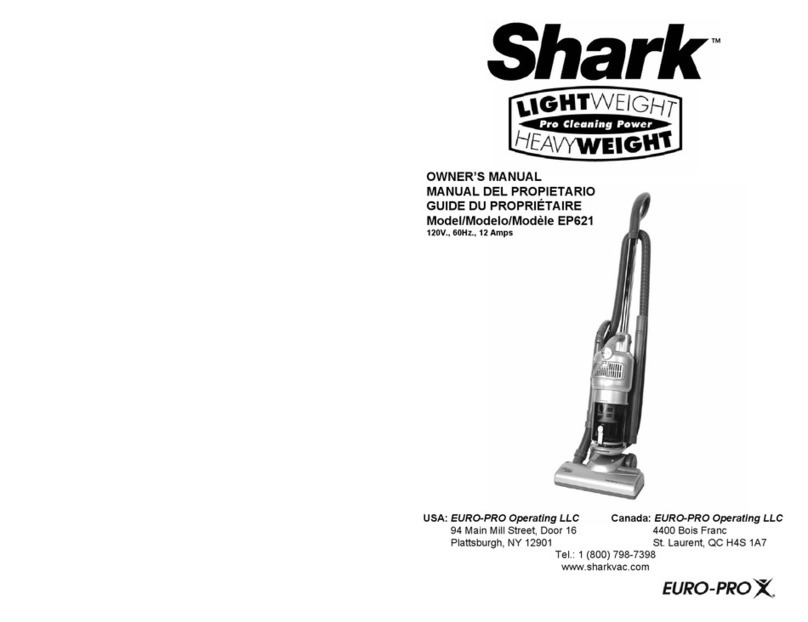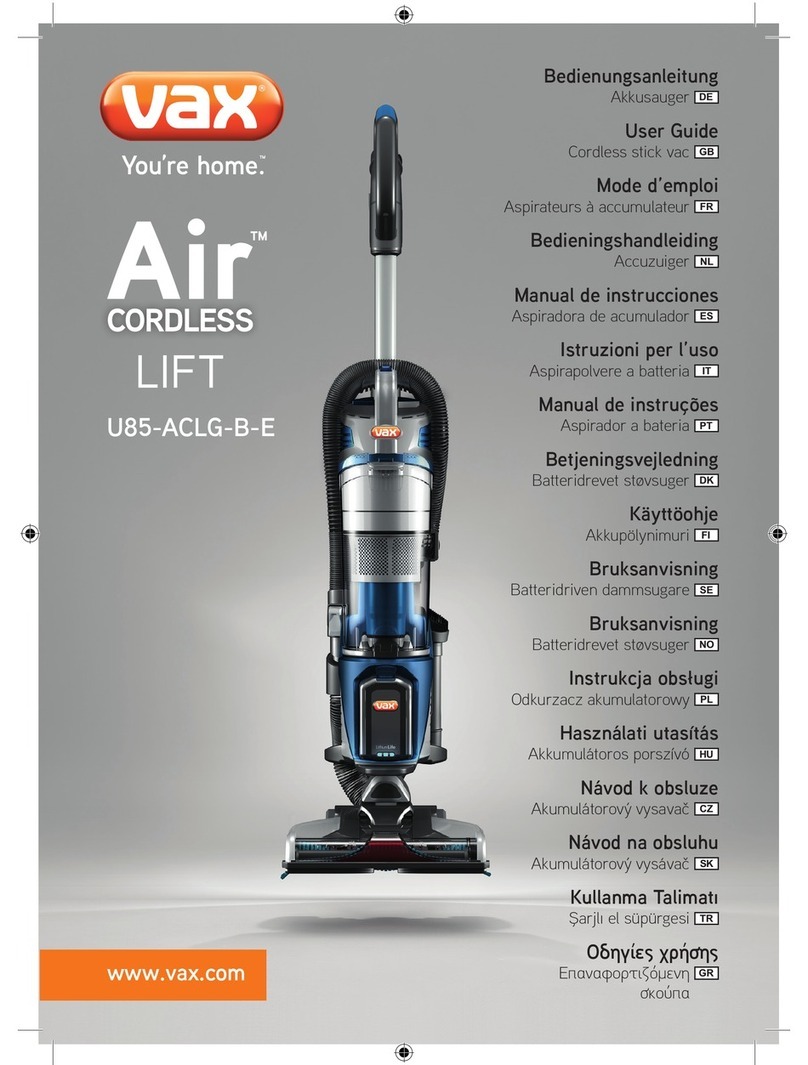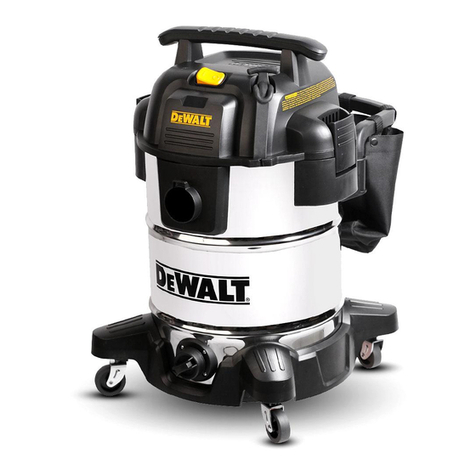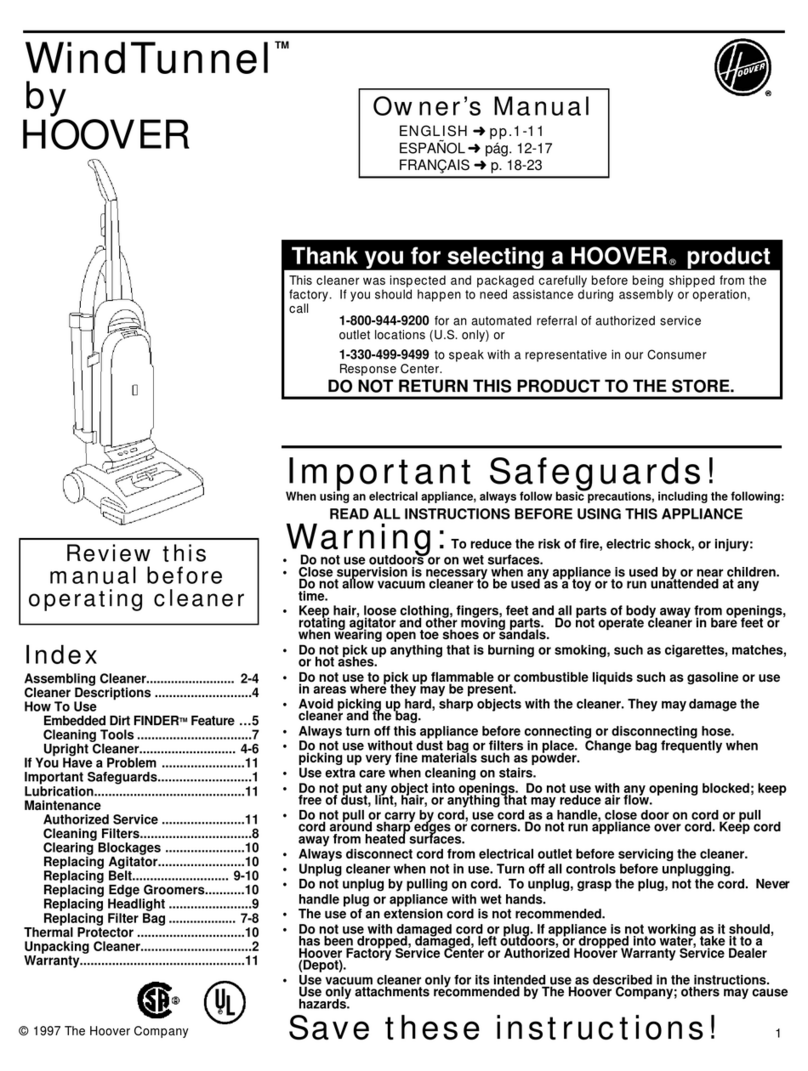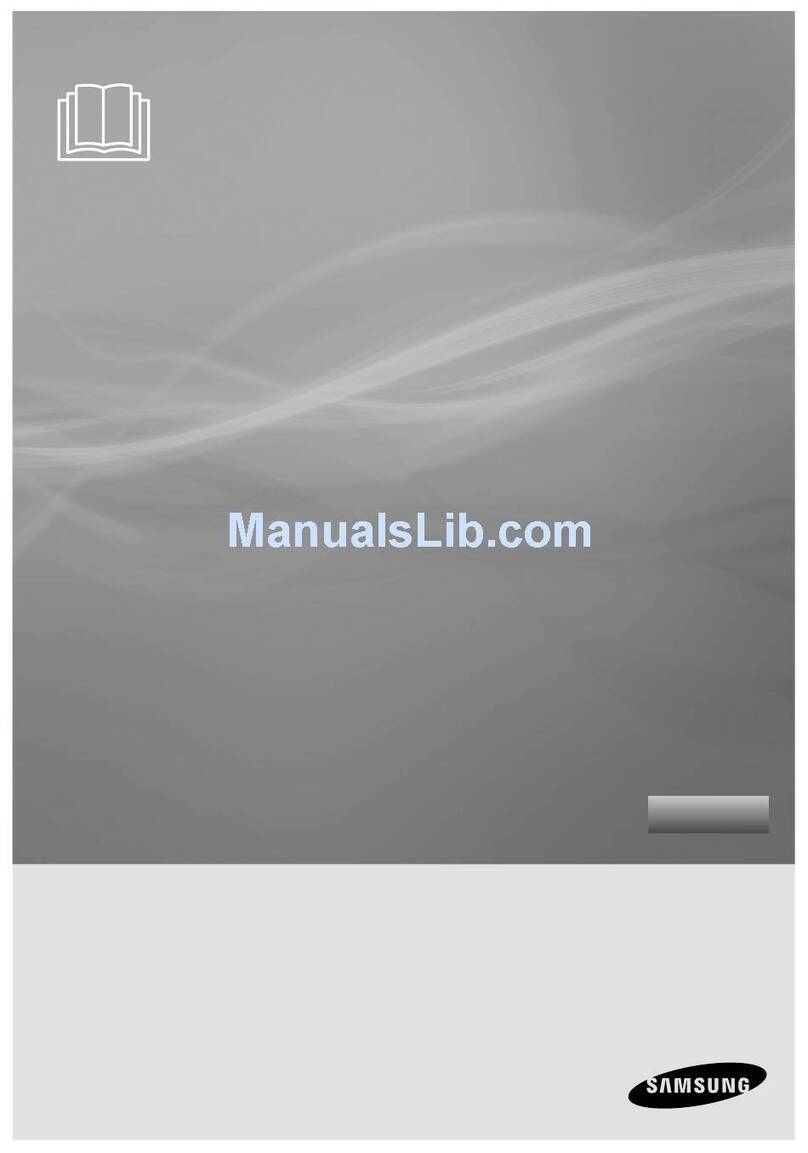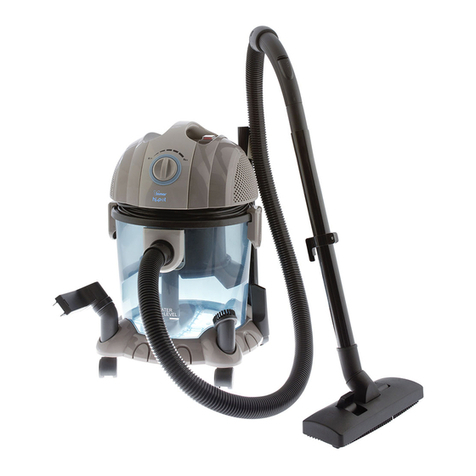Sealey PC100 User manual

INSTRUCTIONS FOR:
WET & DRY VACUUM CLEANER
MODEL No: PC100
1. SAFETY INSTRUCTIONS
2. SPECIFICATION
IMPORTANT: PLEASE READ THESE INSTRUCTIONS CAREFULLY. NOTE THE SAFE OPERATIONAL REQUIREMENTS, WARNINGS & CAUTIONS.
USE THE PRODUCT CORRECTLY AND WITH CARE FOR THE PURPOSE FOR WHICH IT IS INTENDED. FAILURE TO DO SO MAY CAUSE
DAMAGE AND/OR PERSONAL INJURY, AND WILL INVALIDATE THE WARRANTY. PLEASE KEEP INSTRUCTIONS SAFE FOR FUTURE USE.
1.2. GENERAL SAFETY
Disconnect the cleaner from the power supply before servicing,
changing accessories, or performing any maintenance.
Use only genuine parts and accessories. Unauthorised parts
and accessories may be dangerous and will invalidate
your warranty.
Maintain the cleaner in good condition. Use authorised
agent for servicing. Keep machine clean, but DO NOT
use solvents.
For dry vacuuming ensure the cloth filter is firmly in place
before operating the cleaner.
DO NOT operate the unit without a filter in place. Using the
cleaner without a filter will result in motor failure and
will invalidate your warranty.
Wear protective clothing and gloves.
DO NOT allow children or untrained persons to operate the
cleaner.
DO NOT place attachments close to your face (especially
eyes, ears, etc). Do not point the hose end at other
persons or animals.
▲DANGER! DO NOT vacuum hot or glowing ash, cigarette
ends, inflammable, explosive, corrosive or other dangerous
substances.
DO NOT leave machine running unattended. Turn power supply
OFF, and DO NOT leave the vicinity until motor has come to a
complete stop.
DO NOT operate the cleaner while under the influence of
drugs, alcohol or impairing medication, or if you are tired.
DO NOT use the cleaner in the rain or in very damp conditions.
DO NOT use the cleaner for a task it is not designed to
perform.
When not in use, store the cleaner in a safe, dry, childproof
location.
Thank you for purchasing a Sealey product. Manufactured to a high standard this product will, if used according to these instructions and
properly maintained, give you years of trouble free performance.
1.1. ELECTRICAL SAFETY
WARNING! It is the responsibility of the owner and the operator to
read, understand and comply with the following: You must check all
electrical products, before use, to ensure that they are safe. You
must inspect power cables, plugs, sockets and any other connectors
for wear or damage. You must ensure that the risk of electric shock
is minimised by the installation of appropriate safety devices. A
Residual Current Circuit Breaker (RCCB) should be incorporated in
the main distribution board. We also recommend that a Residual
Current Device (RCD) is used. It is particularly important to use an
RCD with portable products that are plugged into a supply which is
not protected by an RCCB. If in any doubt consult a qualified
electrician. You may obtain a Residual Current Device by
contacting your Sealey dealer.
You must also read and understand the following instructions
concerning electrical safety.
1.1.1. The Electricity at Work Act 1989 requires that all portable
electrical appliances, if used on business premises, are tested
by a qualified electrician, using a Portable Appliance Tester
(PAT), at least once a year.
1.1.2. The Health & Safety at Work Act 1974 makes owners of
electrical appliances responsible for the safe condition of
those appliances and the safety of the appliance operators. If
in any doubt about electrical safety, contact a qualified
electrician.
1.1.3. Ensure that the insulation on all cables and on the appliance
is safe before connecting it to the power supply. See 1.1.1.
and 1.1.2. and use a Portable Appliance Tester.
1.1.4. Ensure that cables are always protected against
short circuit and overload.
1.1.5. Regularly inspect power supply cables and plugs for wear
or damage and check all connections to ensure that
none is loose.
1.1.6. Important: Ensure that the voltage marked on the appliance
matches the power supply to be used and that the plug is
fitted with the correct fuse - see fuse rating at right.
1.1.7. DO NOT pull or carry the appliance by the power cable.
1.1.8. DO NOT pull the plug from the socket by the cable.
1.1.9. DO NOT use worn or damaged cables, plugs or connectors.
Immediately have any faulty item repaired or replaced by a
qualified electrician. When a BS 1363/A UK 3 pin plug is
damaged, cut the cable just above the plug and dispose of
the plug safely.
Fit a new plug according to the following instructions (UK only).
a) Connect the GREEN/YELLOW earth wire to the
earth terminal ‘E’.
b) Connect the BROWN live wire to the live terminal ‘L’.
c) Connect the BLUE neutral wire to the neutral terminal ‘N’.
d) After wiring, check that there are no bare wires, that all
wires have been correctly connected, that the cable outer
insulation extends beyond the cable restraint and that the
restraint is tight.
FUSE RATING 13 AMP
Blue
Neutral
Wire
Yellow & Green
Earth Wire
Cable
Restraint
Brown
Live
Wire
Double insulated products, which are always marked with
this symbol , are fitted with live (brown) and neutral
(blue) wires only. To rewire, connect the wires as indicated
above - DO NOT connect either wire to the earth terminal.
1.1.10.Products which require more than 13 amps are supplied without
a plug. In this case you must contact a qualified electrician to
ensure that a suitably rated supply is available. We recommend
that you discuss the installation of an industrial round pin plug and
socket with your electrician.
1.1.11. If an extension reel is used it should be fully unwound before
connection. A reel with an RCD fitted is preferred since any
appliance plugged into it will be protected. The cable core
section is important and should be at least 1.5mm², but to be
absolutely sure that the capacity of the reel is suitable for this
product and for others which may be used in the other output
sockets, we recommend the use of 2.5mm² section cable.
1 Model No: ...................................PC100
2 Motor Power: .................................1000W
3 Supply:.......................................230V
4 Air Flow:....................................90m³/hr
5 Drum Size:.....................................10ltr
6 Weight: ......................................3.3kg
7 Vac Accessories Ø: ............................ 35mm
8 Filter Type:.............................Cloth & Foam
9 Replacement Cloth Filter.................. PC100.ACC4
10 Replacement Foam Filter ................. PC100.ACC2
PC100 Issue: 3(L) - 11/08/16
© Jack Sealey Limited Original Language Version

3. INTRODUCTION & SPECIFICATION
4. CONTENTS & ASSEMBLY
Item ........Description
1 ...............Handle.
2 .......... Power Head.
3 ...........Blower Port.
4 ........... Filter Cage.
5 .....Accessory Storage.
6 ... Cable Stowage Hook.
7 ......Safety Float Valve.
8 .. Flexible Vacuum Hose.
Item ........Description
9 ... Reusable Cloth Filter.
10 ...............Brush.
11.......... Crevice Tool.
12 ..........Foam Filter.
13 ........On/Off Switch.
14 .........Vacuum Port.
15 ........ Locking Knob.
16 ........10ltr Container.
4.1. Ensure the mains plug is disconnected. Do not connect to
the mains power until the unit is correctly assembled and
prepared for the cleaning task in hand.
4.2. Rotate the two locking knobs on either side of the power
head clockwise to release the head.
4.3. Lift the power head off the container and turn it upside
down ready to fit a filter.
4.4. Remove the contents from inside the container and check
the items against the contents list above. If anything is
missing or damaged please contact your supplier
immediately.
4.5a For dry vacuuming fit the reusable cloth filter over the filter
cage.
4.5b. For wet vacuum remove the cloth filter and put the foam
filter over the filter cage.
NOTE: Do not operate the cleaner without any filter fitted as
this will damage the motor and invalidate your
warranty.
4.6. Replace the power head onto the container ensuring that it
is correctly seated.
4.7. Secure the head by turning the locking knobs
anticlockwise.
4.8. Insert the flexible hose into the front inlet port below the
on/off switch.
4.9. Connect the brush or crevice tool to the other end of the
hose.
4.10 When vacuuming is complete the brush and crevice tools
can be stored using the grooved stowage positions on
either side of the power head.
3.1. Introduction.
High powered, lightweight, wet and dry unit with blower facility.
Constructed from high impact composite with tool and hose
stowage points on head. Ideal for vehicle cleaning and general
workshop use. Supplied with crevice and floor tools, cloth and
foam filters, 2mtr cable and 3-pin plug.
fig. 1
PC100 Issue: 3(L) - 11/08/16
© Jack Sealey Limited Original Language Version

WARNING! Ensure you read, understand and apply
Section 1 ‘Safety Instructions’.
Reminder: DO NOT vacuum hazardous substances. Use
of an incorrect filter will invalidate your warranty.
5.1. Whilst you are preparing the machine for use ensure that it is
unplugged from the power supply.
5.2. Remove the power head. Stretch the opening of the
reusable cloth filter over the filter cage and push it down.
5.3 Ensure that the filter completely covers the filter cage
with the elastic portion stretched over the smooth ring of
plastic at the base of the filter cage.
5.4. Reposition the power head onto the container, and secure
in place by rotating the two locking knobs.
5.5. Insert the flexible hose into the front inlet port below the
on/off switch. Push the required attachment onto the free end
of the hose.
5.6. Plug in the power supply.
5.7. Switch the motor on (position ‘I’).
5.8. When you have completed vacuuming, press the switch to
‘Off’ (position ‘O’),and unplug from power supply.
Regularly check the condition of the filter.
5. DRY VACUUM CLEANING
WARNING! Ensure you read, understand and apply Section 1
‘Safety Instructions’. Reminder: Remove plug from power
supply before opening unit. DO NOT vacuum solvents,
explosives, inflammable and/or hazardous liquids such as
petrol, oil, spirits, paint, thinners, acids etc.
6.1. Whilst preparing the unit for use ensure that the machine is
unplugged from the power supply. Make sure the tank is
clean and free from dust and dirt.
6.2. Remove the reusable cloth filter and fit the foam filter over
the filter cage, replace the top section onto the container.
6.3. To the same flexible hose as used in dry cleaning fit the
desired nozzle.
6.4. Ensure the switch is ‘Off’ (position ‘0’) before plugging into
the power supply.
6.5. Press the switch to ‘On’ (position ‘I’).
6.6. After use, empty the tank and dry.
To vacuum large quantities of liquid, from a sink or tank etc., do not
immerse the nozzle completely in the liquid, leave a gap at the top of
the nozzle opening to allow an air inflow. The machine is fitted with a
float valve which stops the suction when the tank has reached its
maximum capacity. The user will notice an increase in motor speed.
When this happens, turn off the machine, disconnect from power
supply, remove the head from the container and empty the liquid into
a suitable receptacle or drain. To continue vacuuming, refit the head
and proceed. After wet vacuuming, turn the machine off and remove
plug from power supply. Empty the container and clean/dry the inside
and outside before storage.
Remember! After wet vacuuming the foam filter must be removed
and a dry cloth filter must be fitted before dry vacuuming again.
6. WET VACUUM CLEANING
7. BLOWING
7.1 Push one end of the flexible hose into the blowing outlet port
in the back of the power head.
7.2 Ensure the power switch is turned off and plug into the
power supply.
7.3 Switch on the power (position ‘I’).
7.4 The unit will now blow through the hose and can be used to
clear obstructions within the pipe.
WARNING! If after a few seconds the hose is still blocked turn
of the unit and clear the hose manually.
PC100 Issue: 3(L) - 11/08/16
© Jack Sealey Limited Original Language Version

10. TROUBLESHOOTING
9. CONSUMABLES
IMPORTANT! IF THE MACHINE IS USED WITHOUT A FILTER FITTED THE MOTOR WILL BURN OUT EVENTUALLY AND YOUR
GUARANTEE WILL BE INVALIDATED. ALWAYS KEEP A SPARE FILTER HANDY.
Replacement Cloth Filter ................................ PC100.ACC4
Replacement Foam Filter................................ PC100.ACC2
Cleaner will not operate.
Dust comes from the motor cover.
Reduced efficiency and increased
motor speed/vibration.
No power supply.
Faulty power cable, switch or motor.
Container full of liquid.
Filter missing or damaged.
Container full.
Filter clogged.
Nozzle, hose or container inlet blocked.
Check supply.
Check and repair or replace faulty item.
Empty container.
Fit or replace filter.
Empty container.
Replace or clean filter (See maintenance)
Check nozzle, hose and container inlet for blockage.
8. MAINTENANCE
8.1 GENERAL MAINTENANCE.
8.1.1 Ensure the machine is unplugged from the power supply.
8.1.2 Disconnect the hose from the container.
8.1.3 Rotate the locking knobs and remove the power head from the
container.
8.1.4 Clear out any dirt or debris from the container and hose.
8.1.5 Clean the foam filter or reusable cloth filter by washing it in a
mild soapy solution. The cloth filter should be thoroughly dry
before it can be used again.
8.1.6 Check that the hose and attachments are undamaged and also
check the power cable. Any damaged parts should be replaced
immediately.
PC100 Issue: 3(L) - 11/08/16
© Jack Sealey Limited Original Language Version
NOTE: It is our policy to continually improve products and as such we reserve the right to alter data, specifications and component parts without prior notice.
IMPORTANT: No liability is accepted for incorrect use of this product.
WARRANTY: Guarantee is 12 months from purchase date, proof of which will be required for any claim.
01284 757500
01284 703534
sales@sealey.co.uk
Sole UK Distributor, Sealey Group,
Kempson Way, Suffolk Business Park,
Bury St. Edmunds, Suffolk,
IP32 7AR
www.sealey.co.uk
Environmental Protection
Recycle unwanted materials instead of disposing of them as waste. All tools, accessories and packaging should be
sorted, taken to a recycling centre and disposed of in a manner which is compatible with the environment.
When the product becomes completely unserviceable and requires disposal, drain off any fluids (if applicable)
into approved containers and dispose of the product and the fluids according to local regulations.
WEEE Regulations
Dispose of this product at the end of its working life in compliance with the EU Directive on
Waste Electrical and Electronic Equipment (WEEE). When the product is no longer required, it must be disposed
of in an environmentally protective way. Contact your local solid waste authority for recycling information.
Other Sealey Vacuum Cleaner manuals

Sealey
Sealey PC20LN User manual
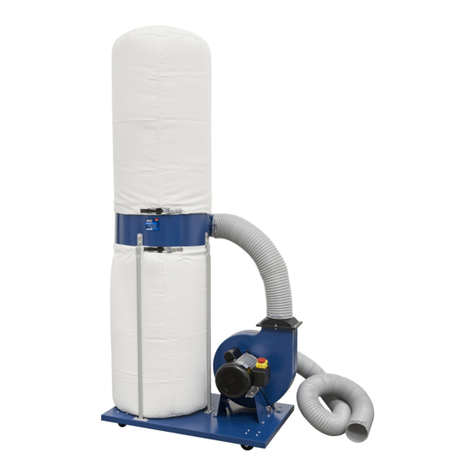
Sealey
Sealey SM47.V3 User manual

Sealey
Sealey CPV100 User manual

Sealey
Sealey CP20VAV User manual

Sealey
Sealey SM47.V3 User manual
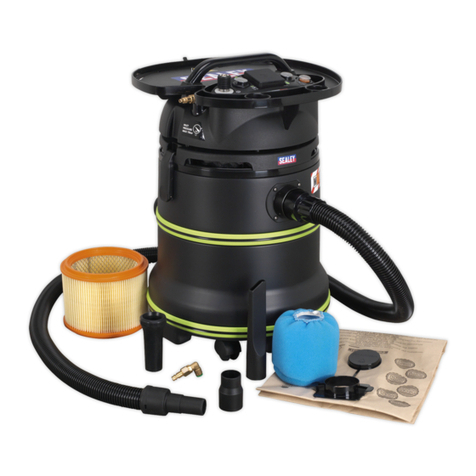
Sealey
Sealey DFS35M User manual

Sealey
Sealey SA317.V2 User manual
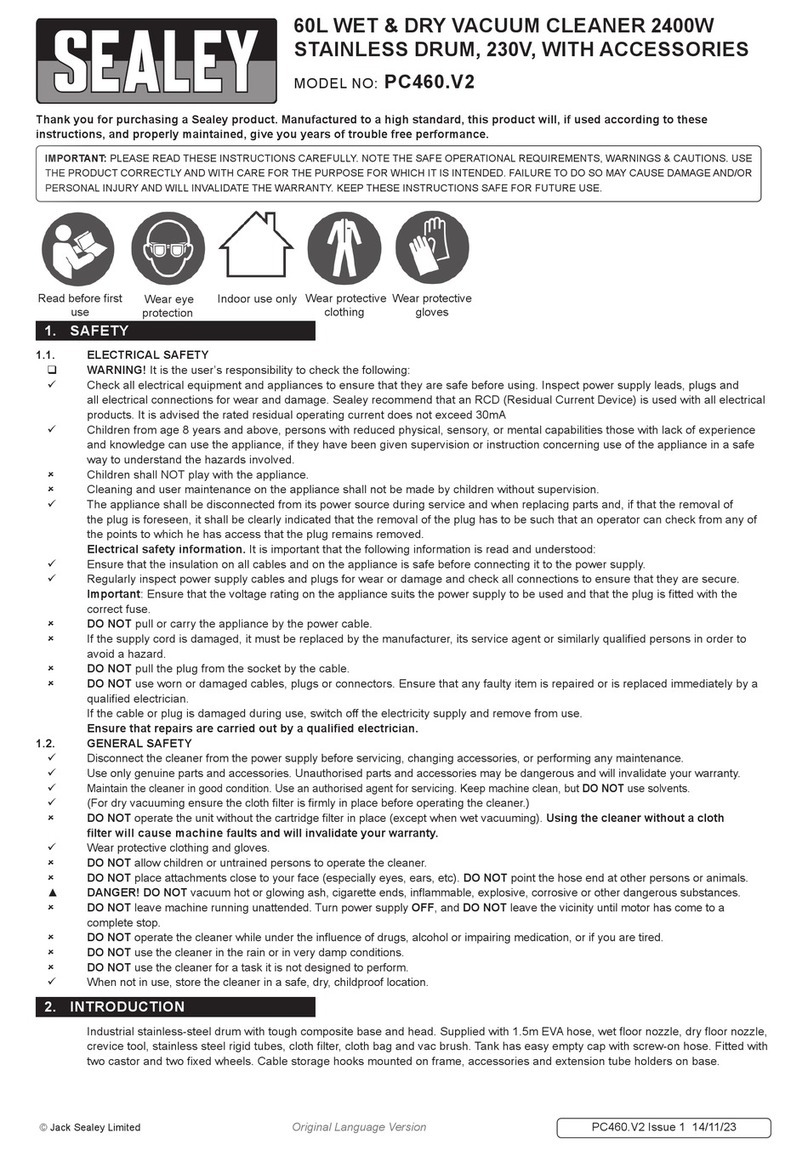
Sealey
Sealey PC460.V2 User manual
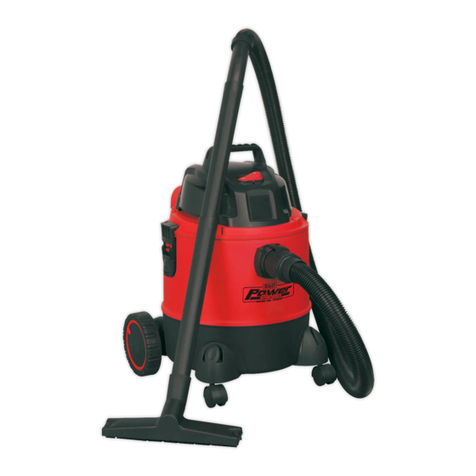
Sealey
Sealey PC200.V3 User manual

Sealey
Sealey PC195SD User manual
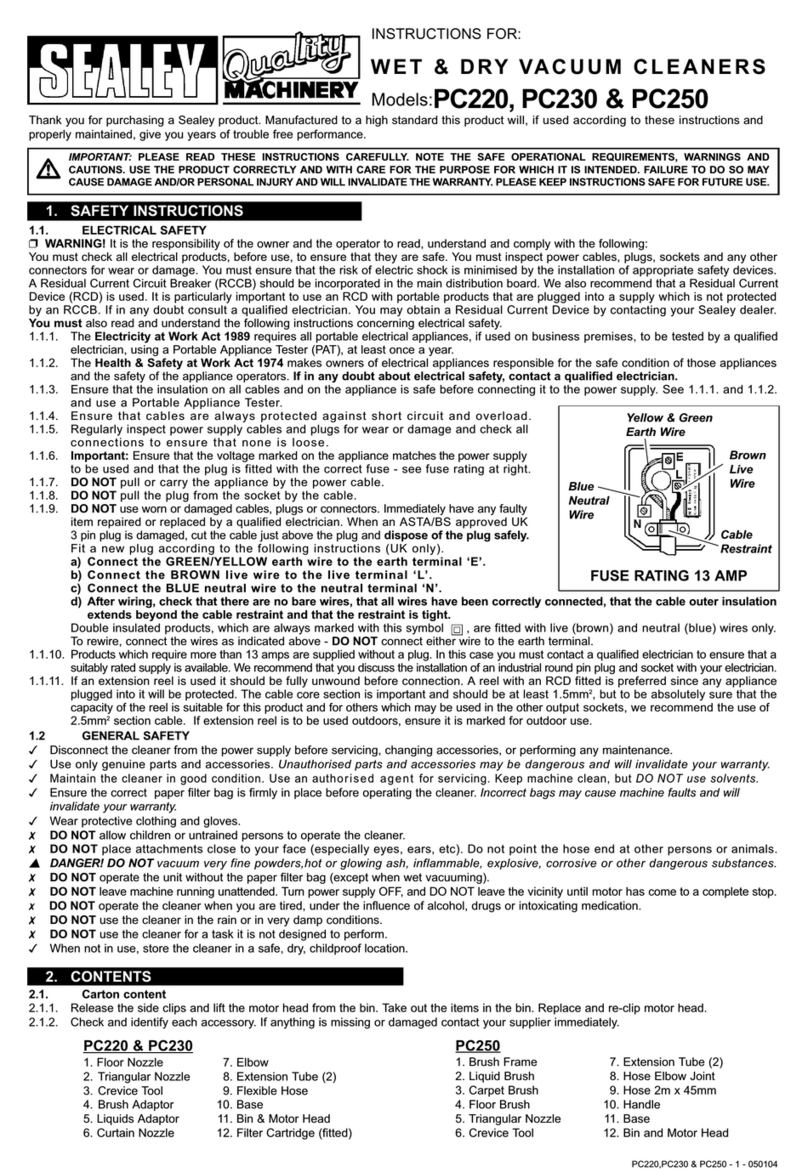
Sealey
Sealey PC220 User manual

Sealey
Sealey PC460 User manual
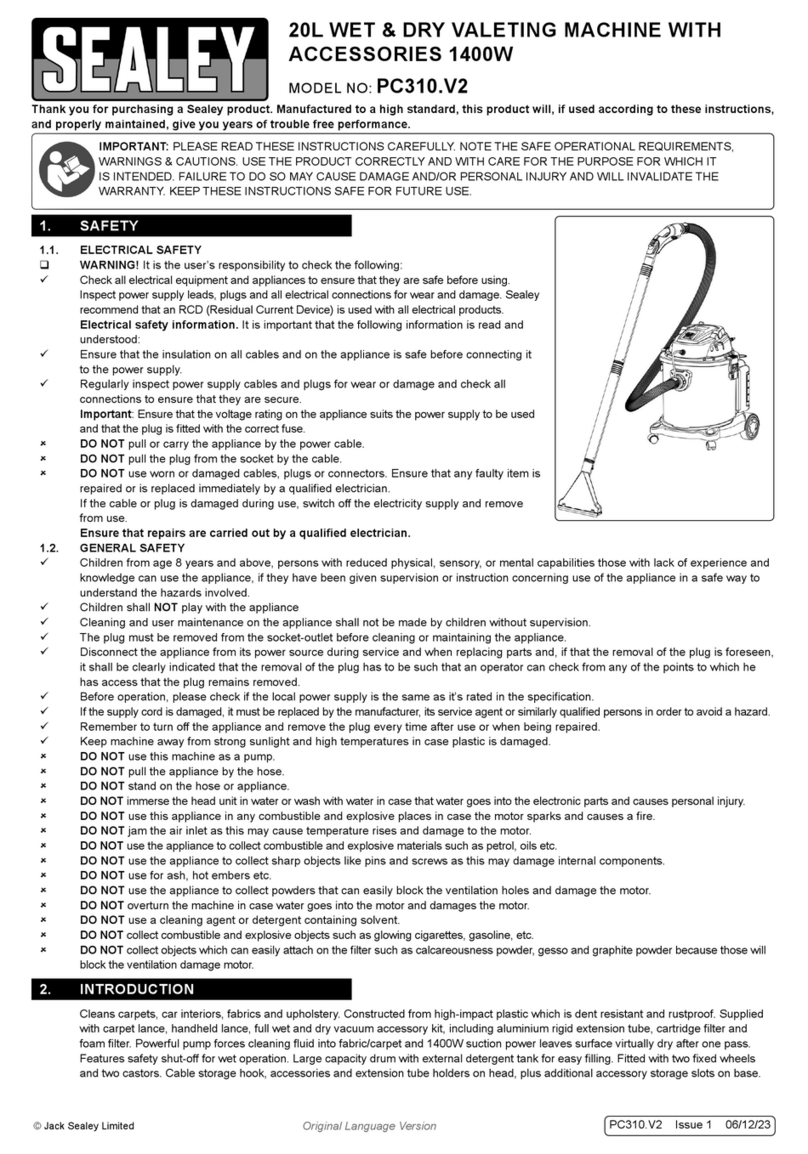
Sealey
Sealey PC310.V2 User manual
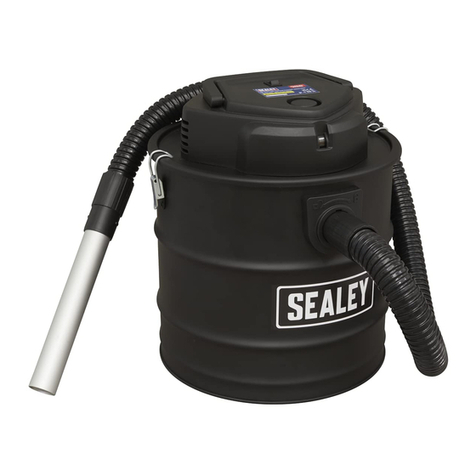
Sealey
Sealey PC200A User manual
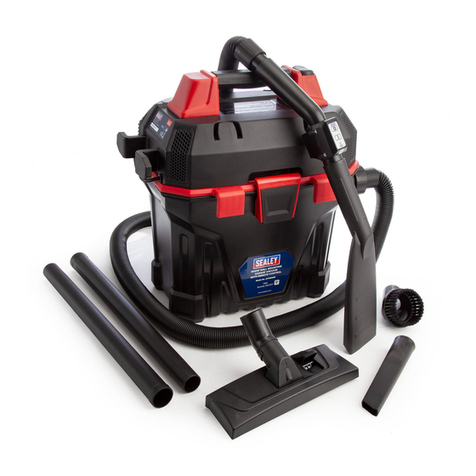
Sealey
Sealey GV180WM User manual

Sealey
Sealey CP20VWDV User manual
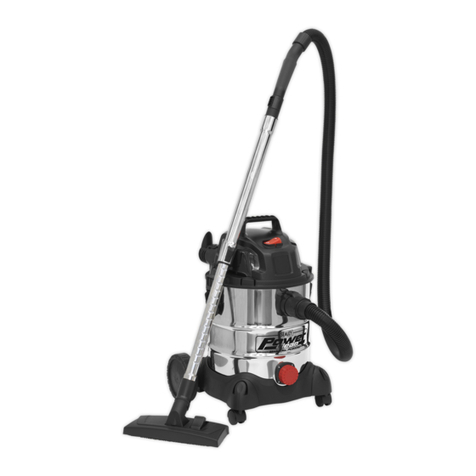
Sealey
Sealey PC200SD.V3 User manual
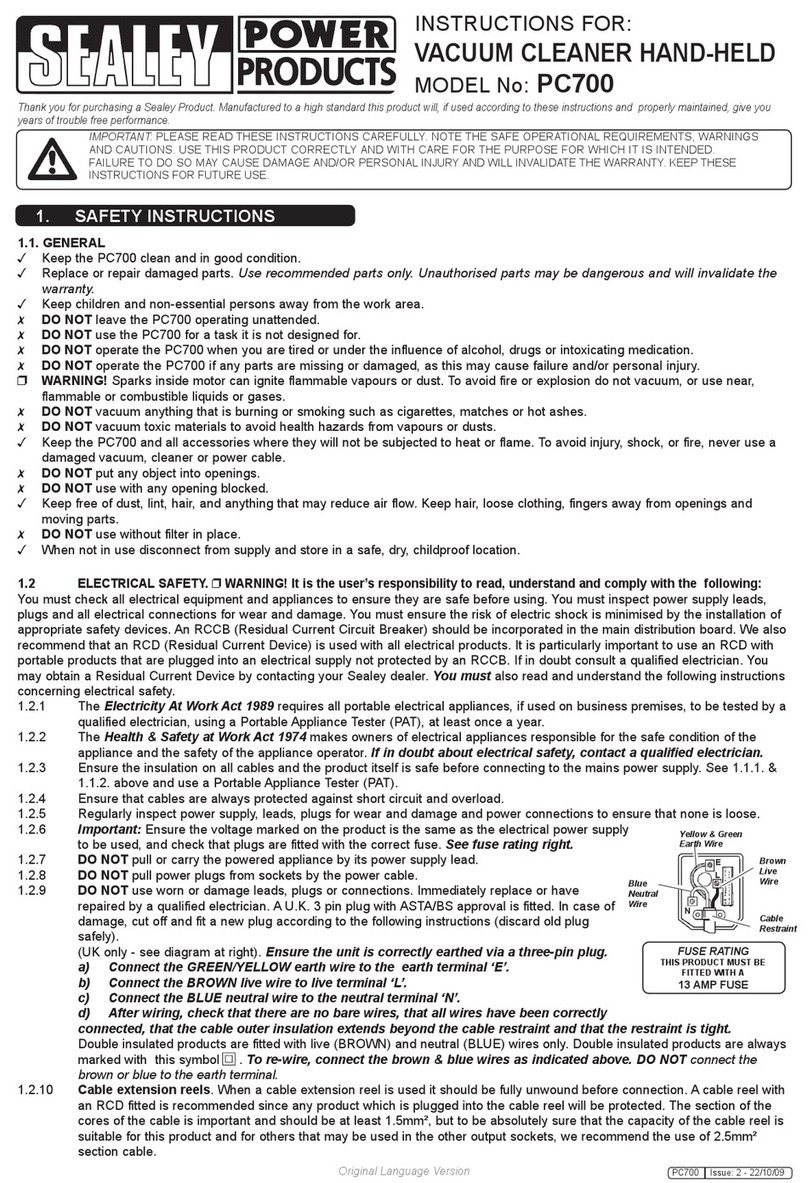
Sealey
Sealey PC700 User manual

Sealey
Sealey PC85 User manual

Sealey
Sealey pc310 User manual

